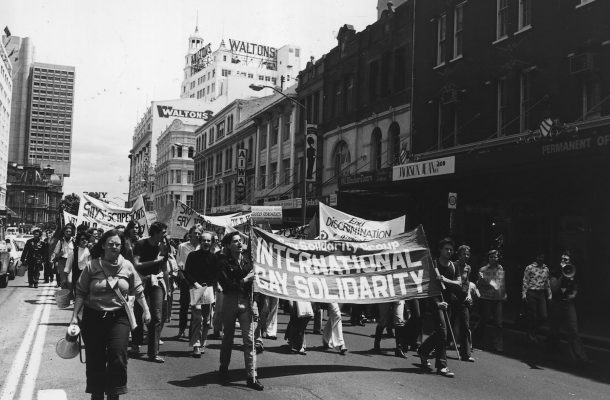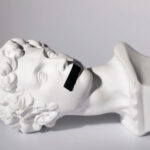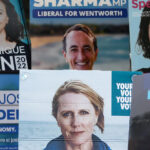Remembering the protests that began Mardi Gras 40 years ago

An estimated 300,000 people turned out for the 2018 parade in March, highlighting just how mainstream LGBT+ culture has become here. And only four months earlier more than 60 per cent of the country voted in support of same-sex marriage laws.
But for Professor Verity Burgmann, one of Australia’s leading political scientists and an expert on protest movements, being in this year’s parade was nothing less than surreal.
Forty years ago, on 24 June 1978, she had been part of the first Mardi Gras – a night time street protest-come party supporting gay and lesbian rights along Sydney’s iconic Oxford Street. On that night, instead of cheers, balloons and sequins, the marchers were met by a violent police crackdown as protestors were grabbed, beaten and thrown in gaol, leaving many traumatised for years afterwards.
Back then, homosexuality was illegal in New South Wales and demonised as immoral by some or considered an illness by others.
“I remember it being absolutely terrifying,” says Professor Burgmann, who became the first female professor of political science at the University of Melbourne in 2003 and is now an Honorary Professorial Fellow in the eScholarship Research Centre.
“The church was saying it was a sin, the medical profession was saying it was an illness and the state was saying it was a crime. But the over-reaction by the police still caught us all by surprise.”
Professor Burgmann was just 25 at the time and active in socialist politics and protest. She was there with gay and lesbian comrades to demonstrate solidarity with another progressive cause.
“I don’t recall unpleasantness from the public watching. We were marching at the back and word came down to us that the police had gone berserk up front, and that’s when we realised that something serious was happening. We linked arms and stayed together for safety. But we got off lightly. It was the gay and lesbian activists at the front who got hammered.”
In all 53 people were arrested, and the Sydney Morning Herald newspaper would later name then all, including their occupations and their addresses, effectively “outing” some.
In her 1993 book Power and Protest, Professor Burgmann writes that the more radical gay and lesbian activism from the early 1970s, which prompted the police violence in 1978, was nonetheless pivotal in the movement’s ultimate success in changing ideas and legislation. Radicalism, she says, is a critical ingredient for social movements dating back to at least the suffragettes in Britain in the early 20th century.
“In the 1970s probably the majority of people were homophobic, to varying degrees. Being homsexual was seen as wrong in some way. That was why it was important for the movement to shift from not just saying that homosexuality was ok and should not be illegal, but to stand up and be proud and demand complete acceptance,” she says.
“The gay pride movement from 1971 was saying being gay or lesbian is good, and that shift was enough to make people in the mainstream start thinking that perhaps homosexuality wasn’t bad.
“Political scientists call it the radical flank effect, which is that you can change mainstream attitudes and secure moderate reforms by demanding much more, by taking an extremist position that most people won’t agree with but which nonetheless helps to shift attitudes because the moderate reform position emerges as the sensible middle ground.”
She says the “radical flank” has been critical to many major social movements.
“The opposition to the Vietnam war had radicals typifying the US as an imperialist aggressor and supporting the Viet Cong, so the majority of people at last were persuaded conscription for this contentious war was wrong, and in the US civil rights movement, the Black Panthers were a more radical counter point to Martin Luther King Jr, who therefore became a saintly figure standing up against racial intolerance and injustice.
“A movement benefits from having a radical flank but it works best if there is also a strong middle ground of people who can become favoured by those in power anxious to reduce the threat from the radicals,” says Professor Burgmann.
“Women’s advisers and other femocrats in Australia achieved heaps, but they got their appointments in the corridors of power because of how angry the radical women’s liberation movement had become in the 1970s and how much the ‘patriarchy’ felt alarmed by this radicalism.
“The gay and lesbian rights movement had the Gay Pride people who argued ‘Gay is Good’ and were prepared to throw eggs at psychiatrists who advocated ‘aversion therapy’ or heckle fundamentalist conservative religious types like Reverend Fred Nile.
“But there were also more moderate law reform associations and counselling services that were lobbying governments to decriminalise and then outlaw discrimination. It was the Gay Pride radicals who enabled the moderates to succeed, because the moderate law reformers came to be seen as the voice of compromise and reason.”
Looking into the future she can see the transgender movement gaining traction as well as the movement targeting male violence against women. Only this month the rape and murder of Eurydice Dixon in Melbourne galvanised 10,000 people to attend a vigil at the murder site.
“At last when something horrific like this happens even the police, and certainly the smart politicians, realise they can’t make the mistake of blaming the victim and just telling women they need to protect themselves, but are now talking about how society has to insist that men stop behaving badly.”
And given how far society has come on gay and lesbian rights, she says she is optimistic that progressive social movements can continue to make ground. On that cold evening in June, Professor Burgmann says she simply couldn’t have imagined an Australia that would vote in favour of same sex marriage.
“It is one of the most extraordinary changes in attitudes and legislation that I have ever witnessed. It is a fantastic achievement.”
That violently repressed protest is now commemorated every Mardi Gras, though thankfully for those in the skimpy outfits, it has been moved to warmer March.
Professor Burgmann and Dr Graham Willett completed a project to digitise over 200 historical documents from the Gay and Lesbian rights movements going back to 1969 in 2017 and made them accessible on the website Reason in Revolt: Source Documents of Australian Radicalism, hosted by the eScholarship Research Centre at the University of Melbourne. The project was funded by the Australian Lesbian and Gay Archives and University of Melbourne. This article was published by Pursuit.
Andrew Trounson is a senior journalist for the University of Melbourne’s Pursuit magazine. He was previously an education correspondent for The Australian.













